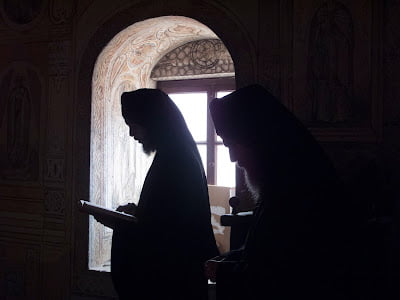A Serbian monk from Hilandar visited the Russian emperor Ivan the Terrible. I would like to make a brief note about one of these interesting monks – Grigorije Vasily.
Monk Grigorije was the abbot of Hilandar between 1583 and 1598, as recorded. He frequently went on diplomatic missions and stayed at the court of Tsar Ivan the Terrible, as well as his successor, Tsar Fyodor I, and Moscow Patriarch Job. When he visited Moscow, he often stayed at the Hilandar endowment in Moscow, a building that Tsar Ivan the Terrible gifted to the monastery in 1556 for the accommodation of visiting monks.
It was recorded that he received the great schema in the tower of Saint Sava in Kareia when he was given his second name, Vasily.
Grigorije also traveled to the Patriarchate of Peć to visit Patriarch Gerasim I and his successor, Savatije I, at a time when Serbia was already under Turkish rule. He wrote diplomatic letters to many rulers, including the Polish King Stephen Báthory and Nikita Romanov, the grandfather of the future Tsar of Russia, Mikhail I Romanov. These letters are preserved in the main archive of the Russian Ministry of Foreign Affairs.
The Translation of a Book for the Russian Tsar
I find it interesting that Monk Grigorije translated a book for the Russian Tsar. What is particularly fascinating is the book in question – Josephus Flavius’ “The Jewish War.” It is said that he translated this book in Kareia in 1598. The first English translation of this work would only come out in 1609. However, some claims suggest that there are even two-century-old Serbian translations of this text, and that Monk Grigorije only adapted the translation for the Russian variant of Old Church Slavonic (Old Serbian).
When we say “translation,” it’s important to note that during the time of Monk Grigorije, the same language—Old Church Slavonic—was spoken in Serbia, Russia, Bulgaria, and most Slavic countries. The monk translated the text from some language and wrote it in the Russian version of Old Church Slavonic, meaning he adapted it for the Russian Tsar.
This text is, of course, almost unknown in our country, but in the West, it caused quite a stir. It seems that the translation was made from an Armenian text or some older Slavic text from the time of Cyril and Methodius, during the fight against the Khazars. Scholars have not been able to prove that it was a translation from Greek because there are some elements in the text that do not appear in Greek versions.
The biggest controversy arose because this translation claims that Christ was not crucified by the Romans, but by the Jews. This, of course, does not align with the Western historical narrative, so the text was heavily criticized and disputed. Some claim that it may have originated from a Macedonian text from the time of the fight against the Khazars, dating back to the time of Cyril and Methodius.
This book and the translation of “The Jewish War” were very popular in Russia, especially in the 19th century. After the fall of Constantinople to the Turks, Russia liberated itself from Mongol rule around 1480 and gradually became a serious empire. This work helped to perceive Moscow as the new Jerusalem.
Serbian Frescoes in the Imperial Cathedral in Moscow
We can assume that due to the efforts of Monk Grigorije, as well as other monks from Mount Athos, Tsar Ivan the Terrible clearly acknowledged the Serbian royal heritage. Historian Sreten Petković claims that the frescoes of Saint Sava, Simeon, and Lazar, painted in 1564 in the Cathedral of the Archangel in Moscow, are evidence of this claim.
The images above show frescoes of our saints from the Cathedral of the Archangel in Moscow. We can notice how similar the depictions of Lazar and Alexander Nevsky are, differing only in the colors.
Russia as the Third Rome
In any case, Monk Grigorije brought the Russian Tsar this translation of “The Jewish War” and the translation of “The Tale of the Fall of Constantinople.” There is a scholarly work that claims that these two works inspired the Russian Tsar with the idea of Russia as the Third Rome. It states that in the Serbian translation of “The Tale of the Fall of Constantinople,” the first mention of Russia as the Third Rome can be found. Specifically, it is said that Constantinople fell as divine punishment because the Greeks attempted to form a union with the Roman Catholics (the Union of Florence), after which God punished them by allowing Constantinople to fall to the Turks. It specifically mentions a part of the text known as the “third Pachomius reduction,” which speaks of the Third Rome, where God, through His saint, St. Sergius of Radonezh, preserved the purity of the Russian Church and how the spiritual center would move from Constantinople to the Russian Church. (Matejic, 2005, page 263.)
Besides these two books, I would mention the Battle of Kosovo and Saint Sava’s Nomocanon, which certainly influenced the formation of the Russian Empire. For Monk Grigorije, this was the most important Orthodox legal book for organizing the state, and it is known that Ivan the Terrible organized his state precisely based on the Nomocanon. As proof that the Nomocanon and the story of the Battle of Kosovo decisively influenced the Russian Tsar, we have the frescoes of Sava, Simeon, and Lazar in Moscow.
As the abbot of Hilandar, Monk Grigorije visited Moscow and the metochions that the monastery had there, as the monastery’s metochions in Serbia, from which it was financed, had been confiscated by the Turks and Sultan Suleiman II. After the Turkish conquest, the hope that Serbia would be able to defend Orthodoxy as it had in previous centuries vanished, and so the focus turned to Russia. Russia was seen as the new empire that would defend the Orthodox faith.
After the Greek rulers began flirting with the idea of a union with the Roman Catholics, a civil war broke out in the 14th century. Tsar Dušan proclaimed an empire and raised the Orthodox banner at the very moment when the Roman Catholic side triumphed in Constantinople. However, Tsar Dušan ruled for only nine years, and after a century, the Serbian Empire succumbed to the blows of the Turks from the east and the Roman Catholics from the west. Russia would once again raise that imperial banner of Orthodoxy.
Thus, a monk from Hilandar in the 16th century helped shape the idea of Russia as the Third Rome and Moscow as the new Jerusalem. We don’t have an image of the humble Grigorije, but it was recorded that he signed as “unlearned and simple,” though he certainly was not.
Note:
I must point out something interesting. Foreign historians say that Monk Grigorije translated from an older Slavic or Macedonian text. Our historians claim that Grigorije translated from Russian to Serbian.
Sources:
https://en.wikipedia.org/wiki/Slavonic_Josephus
https://en.wikipedia.org/wiki/Grigorije_Vasilije
https://kb.osu.edu/server/api/core/bitstreams/a5022e34-d89e-5515-9488-139b8712dbd4/content
https://sh.wikipedia.org/wiki/Slovenski_Josif_Flavije
https://onlinelibrary.wiley.com/doi/10.1002/9781118325162.ch26
The World of Serbian Manuscript Books from the 12th-17th Century, Belgrade 2016.
Mount Athos and Hilandar in the Ottoman Empire, 15th-17th centuries. A. Fotić.







Trackbacks for this post